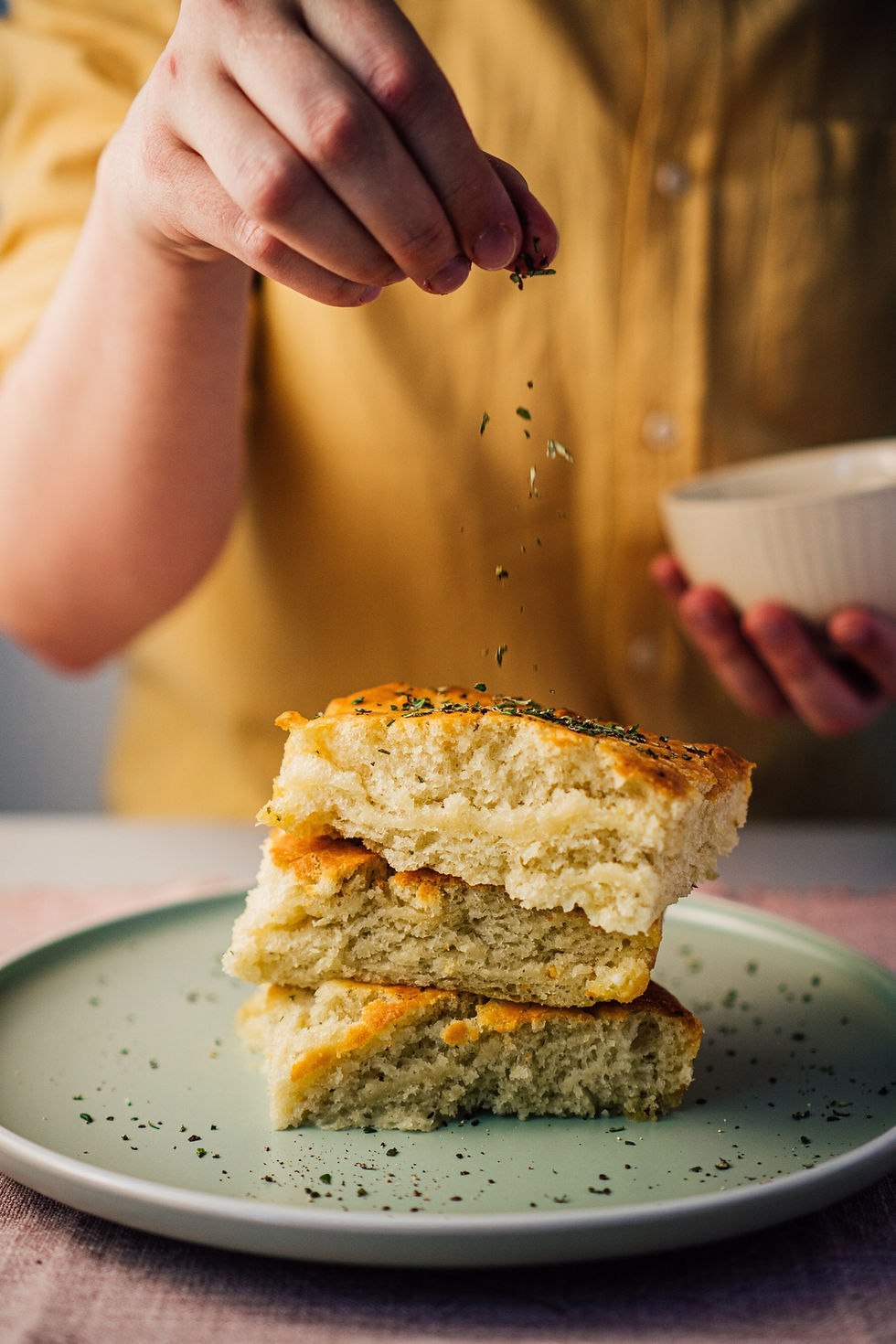Focaccia (Fügassa) alla Genovese
- Feb 10
- 3 min read

Focaccia (Fügassa) alla Genovese
By Master Chef Gianluca Deiana Abis
1. History
Focaccia alla Genovese, known locally as fügassa, is one of the oldest and most iconic breads from Liguria, particularly from the port city of Genoa. While flatbreads date back to ancient Roman times, Genovese focaccia evolved over centuries, taking on its characteristic golden crust, soft interior, and glossy finish. This beloved bread became a part of daily life in Liguria—enjoyed at breakfast dipped into cappuccino, as a snack, or alongside a meal. The secret to its flavor lies in the liberal use of olive oil, sea salt, and the skillful technique of creating dimples in the dough to hold those flavorful pockets of brine and oil. Today, Fügassa is a symbol of Ligurian culinary pride, representing simplicity, quality ingredients, and a rich history that dates back hundreds of years.
2. Step-by-Step RecipeIngredients:
500g (about 4 cups) all-purpose flour
300ml (about 1 1/4 cups) water
40ml (about 3 tablespoons) extra virgin olive oil, plus more for finishing
10g (2 teaspoons) fine sea salt
10g (2 teaspoons) sugar
10g (2 teaspoons) dry yeast or 25g fresh yeast
Coarse sea salt for topping
Instructions:
Prepare the Dough:
Dissolve the yeast and sugar in a small amount of lukewarm water. Let it sit for a few minutes until it becomes foamy.
In a large bowl, mix the flour, salt, and the yeast mixture. Gradually add the remaining water and olive oil.
Knead the dough until smooth and elastic, about 10 minutes by hand or 5 minutes in a stand mixer with a dough hook.
Cover the dough and let it rise in a warm place until it doubles in size (about 1–2 hours).
Shape the Focaccia:
Preheat your oven to 220°C (430°F).
Lightly oil a large rectangular baking sheet.
Roll or press the dough out onto the sheet until it covers the entire surface, about 1–2 cm (1/2 inch) thick.
Cover and let it rest for another 30–45 minutes.
Create Dimples and Brine the Surface:
Mix 3–4 tablespoons of olive oil with 2–3 tablespoons of water.
With your fingers, press deep dimples into the dough across the entire surface. Pour the oil-water mixture over the dough, letting it pool in the dimples.
Sprinkle coarse sea salt generously on top.
Bake:
Bake in the preheated oven for 15–20 minutes, or until the focaccia is golden brown and crispy on the edges.
Remove from the oven and brush with more olive oil while it’s still hot.
Serve:
Let cool slightly before slicing into squares or strips. Serve warm or at room temperature.
3. Pairing
Vermentino (Liguria): A crisp, mineral-driven white wine that complements the olive oil’s richness and the focaccia’s lightly salty flavor.
Pigato (Liguria): With floral and citrus notes, Pigato adds a fresh contrast to the bread’s buttery texture.
Rossese di Dolceacqua (Liguria): A light, fruity red with soft tannins and a hint of spice, balancing the simple, savory qualities of Focaccia alla Genovese.
Prosecco (Veneto): While not Ligurian, a dry Prosecco’s bubbles lift the richness and refresh the palate.
4. Top Bakery/Producer
Panificio Mario (Genoa): A legendary bakery known for its classic Fügassa, made fresh daily using traditional methods.
Antico Forno di Genova (Genoa): A historic spot producing some of the city’s best traditional focaccia.
5. Chef Tips
Always use high-quality extra virgin olive oil—it’s the soul of this dish.
The brine of olive oil and water is crucial. It creates those signature golden spots and enhances the bread’s flavor.
Take your time with each rise. Patience results in a fluffier, more flavorful focaccia.
For an extra touch, sprinkle fresh rosemary or thinly sliced onions on top before baking.
Serve focaccia warm, but it’s also delicious at room temperature. Store leftovers in an airtight container and warm slightly before eating.
6. Best Pair with:
Vermentino or Pigato from Liguria, Rossese di Dolceacqua for a light red, or even a dry Prosecco.
Pair it with soft cheeses, olives, or cured meats for an authentic Ligurian snack.










Comments